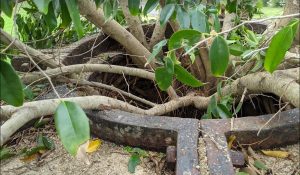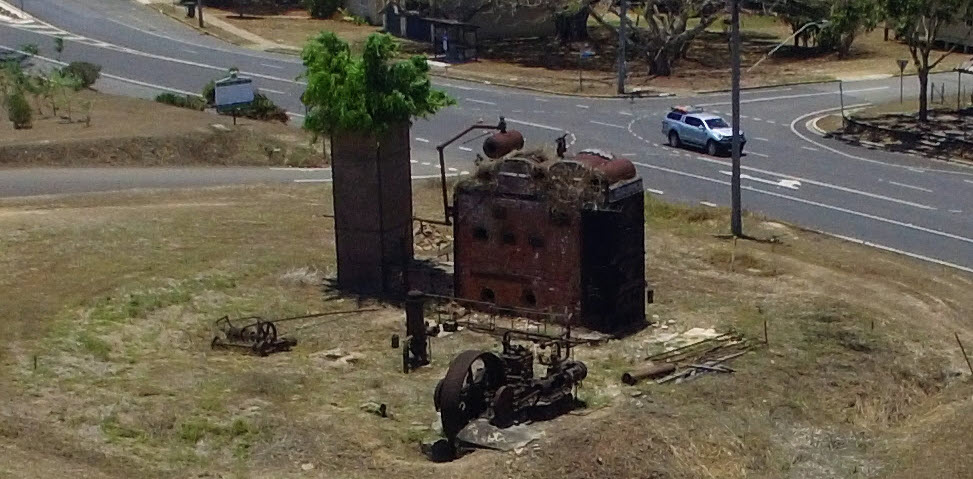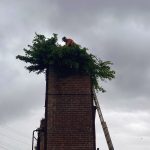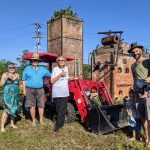A question of balance
One of the striking features of the Boiler Block site is the fig tree growing out of the chimney. Following is a bit of explanation.
Anyone who knows about fig trees understands how powerful they are, and how destructive they can be. We understand this too, so the first thing we’d like to assure everyone if that we know the fig tree has the potential to damage, and eventually destroy, the chimney. Leaving the fig tree there is neither accident nor neglect.

Fig tree clambering out of the top of the chimney.
To understand why we’ve made this decision, let’s all take a moment to step back and look at the sawmill and the fig tree in the big picture. Some people think the fig tree needs to be killed outright. Others think it is appropriate for the fig tree, representing the forests, to reclaim the sawmill and destroy it. In reality, there are many more shades of grey than these either/or arguments would suggest.
Figs are a broad family of ancient plants that have been thriving on the planet since the dinosaurs. Figs are special. They provide a remarkable range of services to the ecosystem and are considered the “Queen of the Rainforest.” They have managed to thrive through times so difficult that most all other living things on earth perished. The secret to their success is their relationship with the tiny wasps that pollinate the flowers inside the hollow fleshy stem that will become a fruit. The figs and the wasps are testament to the enduring wisdom of reciprocity, cooperation, and mutual dependence.
Along with figs our region was once packed with giant Kauri Pine, Cadaghi, Hickory, Red Cedar, and Silky Oak. To the eyes of the colonists who took over this land at the turn of last century, it appeared that the forests had no end.
Timber is an incredibly important resource for people. We are lucky to live in a region where good quality hardwood and softwood timbers can grow reliably. But this is a privilege. Forests are home to an astonishing complexity of life: trees are the centre points in a dazzling web of relationships that emerge between the soils, the skies, and the waters. When we remove a tree and convert it to our purposes, we should be fully aware of the sacrifice imposed upon the living community we have taken it from. In a deep sense, we remove the tree from ourselves as well.
This sense of inter-relationship (and interdependency) does not come easily to colonial cultures. The pioneers who brought their axes to these forests were motivated by the need to provide for their own families. The forests offered tremendous practical wealth: timber for houses, bridges, and wagons; wood for heat, leaves for shade and soils.
So development proceeded. The sawmill was built and countless life-giving trees were felled and put to the blade. The sawmill began serving a short-sighted human impulse to take more and more. By the 1960’s it was clear that our region’s forests were in steep decline, yet the sawmillers continued to over-exploit them. The townsfolk thought their lives depended on infinite economic expansion and, although many were sad that the mighty woodlands had been reduced to anaemic remnants, they could not see how to stop themselves. Their sawmill screamed through the corpses of the forest, ripping the ancient heart out of their country in exchange for a miserly wage.
Eventually, outsiders (and a few locals) managed to get World Heritage declared over the remaining patches of bush. But this process itself was extreme, shutting down all the local opportunities that could have come from a sustainable tropical hardwood industry. The sawmill was silenced, and the fig tree patiently started to devour the ruins of what had once been an engine of local employment, with a potential for long-term self-sufficiency.
People are part of life. In modern times we have forgotten this and behave as if the only important matters are of our own imaginings. But there is a growing awareness that people and country are in a continuous flow of reciprocity and mutual co-dependence. This more proper understanding demands that, even as we harvest resources to meet our basic needs, we are obligated to return the necessary care and respect to allow the other-than-human world to flourish as well.
There is no formula for this: there is no simplistic resolution, as if the world would be better if only there were no humans, or if humans had no need of fig trees. The answer is not to kill the fig tree to save the sawmill relics, or to abandon the sawmill and (figuratively) erase ourselves. The world is a more imaginative, beautiful, and complex place than either of those two positions suggest.
So we will use this as an opportunity to remind ourselves of an ongoing and respectful conversation. Once a year we will prune the fig tree back so that it doesn’t have the power to severely damage the chimney. In between time, it will grow, set seed, and provide its gifts of life to the land.
Thus, the Old Boiler Block Fig will serve to remind us of the sacred relationship we are enmeshed in as fellow beings, no worse and certainly no better, all nurtured by country.




